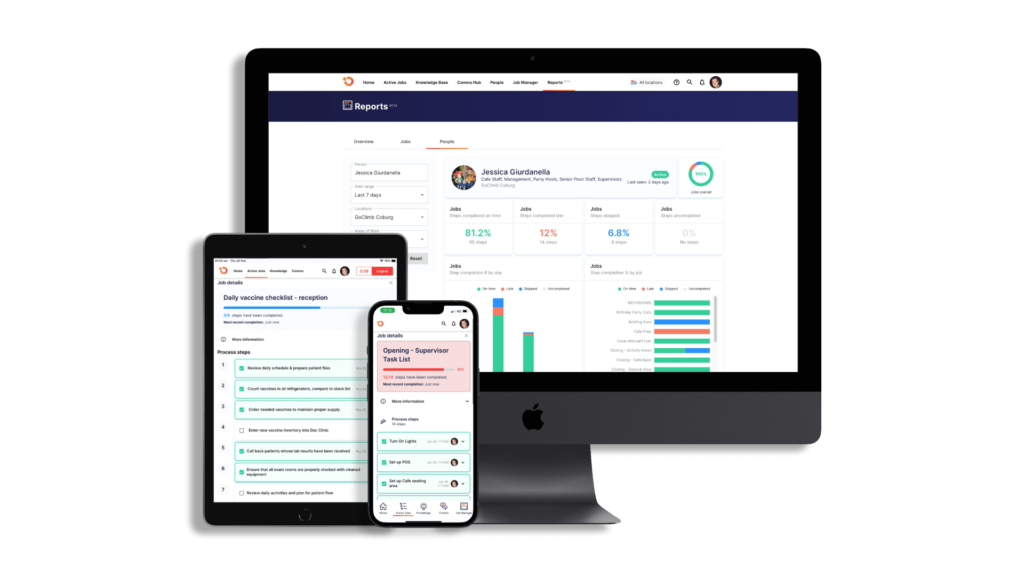What is meant by Workforce Productivity?
When it comes to improving businesses, it’s easy to throw around “workforce productivity”, but what is meant by workforce productivity?
At first glance, it sounds like a broad term, which can make it difficult to use when talking about your business, particularly if you have different departments. After all, what constitutes workforce productivity for one department is different from another, right?
Don’t worry, it’s less complicated than it sounds. This article will help you understand workforce productivity and how it applies to your business.
How do you define workforce productivity?
No matter what your business; you can measure workforce productivity with the following statement – workforce productivity equals output per hour.
Keep in mind that there is a difference between workforce productivity and employee productivity. As the names suggest; workforce productivity defines the productivity of your business as a whole while employee productivity is how you define the productivity of a single employee.
Workforce productivity lets you know whether or not there are gaps in your procedures that are causing lapses in productivity, while employee productivity is an indicator of whether you need to address a single employee’s work.
How do you measure workforce productivity?
In order to measure workforce productivity, you select two different points in time (e.g. the start and the end of the financial year). Then, for each of those points, you divide the total output by the total number of labor hours.
What this will do is reveal any trends in workforce productivity over the time in between those two points. This gives you an indication as to whether your workforce productivity has increased or decreased, which should then inform your business decisions going forward.
How can you improve workforce productivity?
There are many ways to improve workforce productivity, but some methods are more effective than others. The goal isn’t to improve productivity in the short term with small fixes. While short term work productivity is important, the goal is to implement solutions that effectively change the culture of your business in order to increase your workforce productivity in the long term.
To achieve this, we’ve listed the three most effective ways to improve your workforce productivity in the long term in our next section.
Embrace software and technology

This is a non-negotiable. There are constant updates to technology that will significantly aid your workforce. Few are larger than Operandio, a software solution that offers you many different ways to monitor and boost your workforce productivity, such as;
- Using a live dashboard that shows you trends in workforce productivity in real time
- Viewing the results of your work delegation – such as which tasks are being completed and by who
- Checking your workloads and schedules in order to easily adjust your current plans
- Viewing all the resources available to you and your workforce at any given moment
- Having the necessary data to anticipate and plan around any potential risks that could significantly affect your workforce productivity
Physical capital
Investing in your business sounds like a no-brainer. However, there needs to be thought put into where you spend your money to make sure that you effectively improve your business. Infrastructure is only worth it if it helps your business produce at a higher rate, regardless of how much it costs. If you focus on expensive infrastructure without assessing how effective it is for your business specifically, you might be able to impress your workforce into temporarily increasing their productivity, but productivity will stagnate long term.
In short; invest in physical capital, but make sure you can justify it long term as well.
Education and training
If you find that your workforce productivity isn’t where it should be, you should consider that there might be gaps in your staff training that need to be addressed. How effective are your onboarding procedures? How efficient are your production practices?
A decrease in employee productivity can usually be resolved through discussion with said employee, but a decrease in workforce productivity is an indication of a broader problem whose solution means addressing broader problems.
Don’t be afraid to retrain your staff if need be. It might seem like an unnecessary cost of time and money initially; but, if done correctly, the benefits will increase your workforce productivity significantly.
What is the best workforce productivity software (and why)?
As previously mentioned, workforce productivity is one of the many parts of your business that Operandio can boost. It has several features that all work together seamlessly so your business can perform at its peak.
These Operandio features help aspects of business such as;
- Project management
- Learning management
- Scheduling
- Communication
- Data analysis.
You won’t just grow your business – you’ll grow it to a level that you didn’t think possible. Request your free demo today, and take control of your business.


